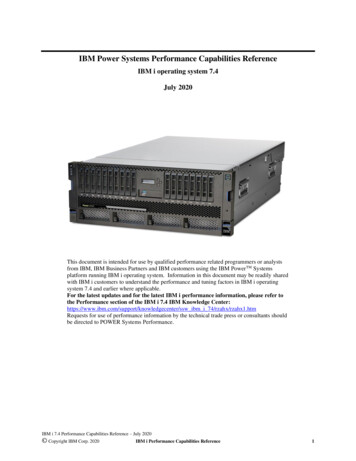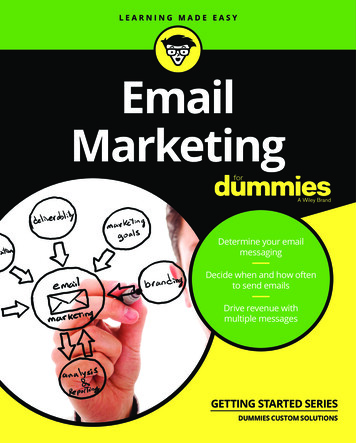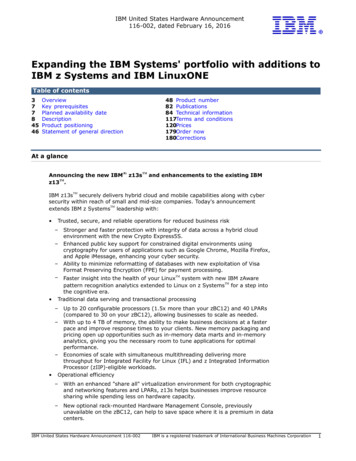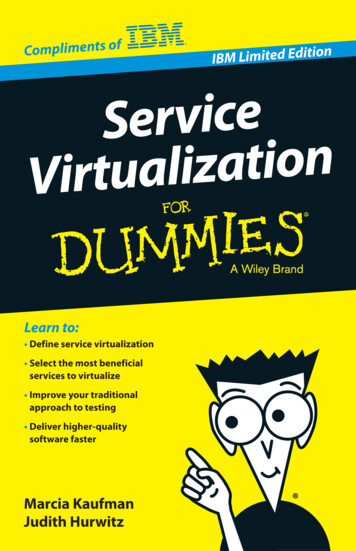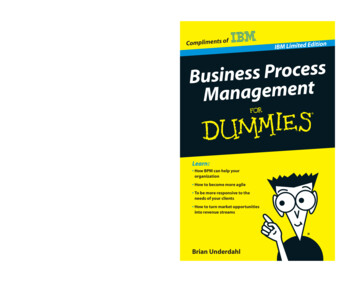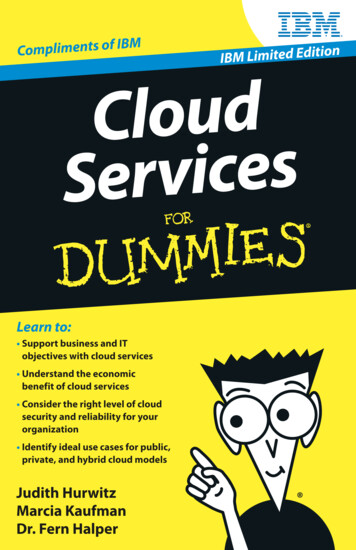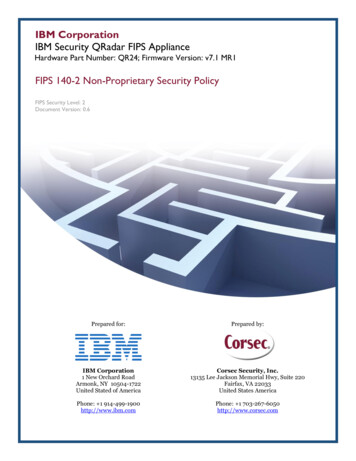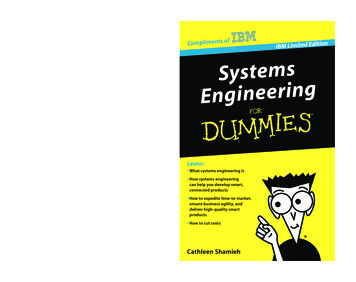
Transcription
Compliments ofUnderstand the problem thatsystems engineering aims to solve Real-world companiesthat benefit from systemsengineering How to build the rightsystem with validationand verification Ways to generate smarterproductsSystems EngineeringSystems engineering is an interdisciplinary approachto creating large, complex systems that meet adefined set of business and technical requirements.The aerospace and defense industries have beenusing systems engineering for a long time, andmuch of what they’ve learned is now being appliedin other industries. As cars, phones, and TVs becomesmarter, you need space-age methods to buildthem. With Systems Engineering For Dummies, IBMLimited Edition, you get an understanding of thebones of the topic and delve into ways to solveproblems and create better business.Open the book and find:SystemsgnireenigEn What are smart products — they warranta new approach to systems development. Understand the systems developmentprocess — get a high-level overview ofsystems engineering Take a look at modeling — enhance yourunderstanding of system structure andbehavior Enhance collaboration — bring togetheryour development teamsMaking Everything Easier! Learn: What systems engineering isGo to Dummies.com How systems engineeringcan help you develop smart,connected productsfor videos, step-by-step examples,how-to articles, or to shop! How to expedite time-to-market,ensure business agility, anddeliver high-quality smartproducts How to cut costsShamiehISBN: 9781118100011Not for resalenIBM Limited EditioCathleen Shamieh
These materials are the copyright of Wiley Publishing, Inc. and anydissemination, distribution, or unauthorized use is strictly prohibited.01 9781118100011-ffirs.indd i5/16/11 11:27 AM
SystemsEngineeringFORDUMmIES‰IBM LIMITED EDITIONCathleen ShamiehThese materials are the copyright of Wiley Publishing, Inc. and anydissemination, distribution, or unauthorized use is strictly prohibited.01 9781118100011-ffirs.indd i5/16/11 11:27 AM
Systems Engineering For Dummies, IBM Limited EditionPublished byWiley Publishing, Inc.111 River StreetHoboken, NJ 07030-5774www.wiley.comCopyright 2011 by Wiley Publishing, Inc., Indianapolis, IndianaPublished by Wiley Publishing, Inc., Indianapolis, IndianaNo part of this publication may be reproduced, stored in a retrieval system or transmitted in anyform or by any means, electronic, mechanical, photocopying, recording, scanning or otherwise,except as permitted under Sections 107 or 108 of the 1976 United States Copyright Act, without theprior written permission of the Publisher. Requests to the Publisher for permission should beaddressed to the Permissions Department, John Wiley & Sons, Inc., 111 River Street, Hoboken, NJ07030, (201) 748-6011, fax (201) 748-6008, or online at http://www.wiley.com/go/permissions.Trademarks: Wiley, the Wiley Publishing logo, For Dummies, the Dummies Man logo, A Referencefor the Rest of Us!, The Dummies Way, Dummies.com, Making Everything Easier, and related tradedress are trademarks or registered trademarks of John Wiley & Sons, Inc. and/or its affiliates in theUnited States and other countries, and may not be used without written permission. All other trademarks are the property of their respective owners. Wiley Publishing, Inc., is not associated with anyproduct or vendor mentioned in this book.LIMIT OF LIABILITY/DISCLAIMER OF WARRANTY: THE PUBLISHER AND THE AUTHOR MAKENO REPRESENTATIONS OR WARRANTIES WITH RESPECT TO THE ACCURACY OR COMPLETENESS OF THE CONTENTS OF THIS WORK AND SPECIFICALLY DISCLAIM ALL WARRANTIES,INCLUDING WITHOUT LIMITATION WARRANTIES OF FITNESS FOR A PARTICULAR PURPOSE.NO WARRANTY MAY BE CREATED OR EXTENDED BY SALES OR PROMOTIONAL MATERIALS.THE ADVICE AND STRATEGIES CONTAINED HEREIN MAY NOT BE SUITABLE FOR EVERY SITUATION. THIS WORK IS SOLD WITH THE UNDERSTANDING THAT THE PUBLISHER IS NOTENGAGED IN RENDERING LEGAL, ACCOUNTING, OR OTHER PROFESSIONAL SERVICES. IF PROFESSIONAL ASSISTANCE IS REQUIRED, THE SERVICES OF A COMPETENT PROFESSIONALPERSON SHOULD BE SOUGHT. NEITHER THE PUBLISHER NOR THE AUTHOR SHALL BE LIABLEFOR DAMAGES ARISING HEREFROM. THE FACT THAT AN ORGANIZATION OR WEBSITE ISREFERRED TO IN THIS WORK AS A CITATION AND/OR A POTENTIAL SOURCE OF FURTHERINFORMATION DOES NOT MEAN THAT THE AUTHOR OR THE PUBLISHER ENDORSES THEINFORMATION THE ORGANIZATION OR WEBSITE MAY PROVIDE OR RECOMMENDATIONS ITMAY MAKE. FURTHER, READERS SHOULD BE AWARE THAT INTERNET WEBSITES LISTED INTHIS WORK MAY HAVE CHANGED OR DISAPPEARED BETWEEN WHEN THIS WORK WAS WRITTEN AND WHEN IT IS READ.For general information on our other products and services, please contact ourBusiness Development Department in the U.S. at 317-572-3205. For details on how tocreate a custom For Dummies book for your business or organization, contact info@dummies.biz. For information about licensing the For Dummies brand for products orservices, contact BrandedRights&Licenses@Wiley.com.ISBN: 978-1-118-10001-1Manufactured in the United States of America10 9 8 7 6 5 4 3 2 1These materials are the copyright of Wiley Publishing, Inc. and anydissemination, distribution, or unauthorized use is strictly prohibited.01 9781118100011-ffirs.indd ii5/16/11 11:27 AM
Publisher’s AcknowledgmentsWe’re proud of this book and of the people who worked on it. For details on how tocreate a custom For Dummies book for your business or organization, contact info@dummies.biz. For details on licensing the For Dummies brand for products or services, contact BrandedRights&Licenses@Wiley.com.Some of the people who helped bring this book to market include the following:Acquisitions, Editorial, andMedia DevelopmentProject Editor: Carrie A. BurchfieldEditorial Manager: Rev MengleSr. Acquisitions Editor: Katie FeltmanBusiness Development Representative:Sue BlessingCustom Publishing Project Specialist:Michael SullivanComposition ServicesSr. Project Coordinator: Kristie ReesLayout and Graphics: Melanee HabigProofreader: Jessica KramerPublishing and Editorial for Technology DummiesRichard Swadley, Vice President and Executive Group PublisherAndy Cummings, Vice President and PublisherMary Bednarek, Executive Director, AcquisitionsMary C. Corder, Editorial DirectorPublishing and Editorial for Consumer DummiesDiane Graves Steele, Vice President and Publisher, Consumer DummiesComposition ServicesDebbie Stailey, Director of Composition ServicesBusiness DevelopmentLisa Coleman, Director, New Market and Brand DevelopmentThese materials are the copyright of Wiley Publishing, Inc. and anydissemination, distribution, or unauthorized use is strictly prohibited.01 9781118100011-ffirs.indd iii5/16/11 11:27 AM
Contents at a GlanceIntroduction . . . . . . . . . . . . . . . . . . . . . . . . . . . . . . . . . . . . . .1Chapter 1: Generating Smarter Products . . . . . . . . . . . . .3Chapter 2: Taming the Tiger withSystems Engineering . . . . . . . . . . . . . . . . . . . . . . . . . . .13Chapter 3: Revolutionizing Requirements . . . . . . . . . . . .23Chapter 4: Getting Abstract with System Modeling . . .35Chapter 5: Ensuring Tip-Top Quality . . . . . . . . . . . . . . . .43Chapter 6: Enabling Large Teams to Collaborateand Manage Changes . . . . . . . . . . . . . . . . . . . . . . . . . .51Chapter 7: Ten Ways to Win withSystems Engineering . . . . . . . . . . . . . . . . . . . . . . . . . . .61These materials are the copyright of Wiley Publishing, Inc. and anydissemination, distribution, or unauthorized use is strictly prohibited.02 9781118100011-ftoc.indd iv5/16/11 11:27 AM
IntroductionSmart products are everywhere. They track your packages, control traffic lights, fly aircraft, and guide you toyour destination. They’re at the heart of the systems and services you use every day — from smartphones to smart cars,to medical systems, and to aerospace and defense systems.Intelligent, instrumented, and interconnected products arerevolutionizing the way we interact with each other and perform everyday tasks. Through a combination of electronics,software, sensors, and other hardware, we have the technology to create multifunctional customized products. And withour unlimited imaginations, we have the potential to definehundreds of innovative, value-driven, and personalized systems and services.The real challenge in creating smart products is one of organization: how can we effectively and efficiently integrate acomplex combination of technologies to create an intelligent“system of systems” that fulfills its promises and lives up toits potential? The solution lies with systems engineering.Systems Engineering For Dummies, IBM Limited Edition,explains what systems engineering is and how it can help youharness the complexity inherent in developing smart, connected products. If you’re looking for ways to expedite timeto-market, ensure business agility, and deliver high-qualitysmart products while cutting costs, Systems Engineering ForDummies, IBM Limited Edition, is the book for you.How This Book Is OrganizedThe seven chapters in this book are geared to help you understand the problem that systems engineering aims to solveand all the steps involved in solving it. Here’s an overview ofwhat’s inside:These materials are the copyright of Wiley Publishing, Inc. and anydissemination, distribution, or unauthorized use is strictly prohibited.03 9781118100011-intro.indd 15/16/11 11:27 AM
2Systems Engineering For Dummies, IBM Limited Edition Chapter 1 explains what smart products are and whythey warrant a new approach to systems development. Chapter 2 provides a high-level overview of systemsengineering. Chapter 3 lays out the critical role requirements playthroughout the systems development cycle. Chapter 4 shows you how models can enhance yourunderstanding of system structure and behavior. Chapter 5 explains how to make sure you build theright system (validation) and build the system right(verification). Chapter 6 suggests ways to enhance collaboration amongdevelopment teams. Chapter 7 provides a look at some real-world companiesthat have incorporated systems engineering into theircore business practices.Icons Used In This BookAs you read this book, you’ll notice several eye-catching iconsdesigned to highlight special information.This icon alerts you to key concepts you might want tocommit to memory.This icon appears next to actionable suggestions that aremeant to make your life a lot easier.These are the opposite of tips. They’re suggestions that, ifignored, are bound to make your life a lot harder.I realize that you don’t necessarily need to know everything Ido, so this icon tells you a little more detail than is absolutelynecessary, so you can skip it if you like.These materials are the copyright of Wiley Publishing, Inc. and anydissemination, distribution, or unauthorized use is strictly prohibited.03 9781118100011-intro.indd 25/16/11 11:27 AM
Chapter 1Generating SmarterProductsIn This Chapter Dealing with the demand for intelligent, interconnected systems Recognizing challenges on the road to success Shifting gears to encompass a broader landscapePicture this: As you back down your driveway, your carsends a signal to your home to arm the alarm systemand close the garage door. Your cell phone automaticallysynchronizes with your car’s voice command system, and thebuilt-in global positioning system (GPS) analyzes live trafficpatterns and suggests a time-saving alternate route to work.Your car announces it’s due for an oil change, checks yourschedule on your smartphone, suggests possible appointmenttimes, and offers to initiate a call to your favorite service station. Your car can even inform you of potential flooding conditions expected during your commute home.Is it possible that a vehicle that was once known as a “horseless carriage” could be so incredibly smart and helpful?Absolutely!In this chapter, you discover what makes smart products tick,how they collaborate with each other, and why you shouldadopt new business processes for developing them.These materials are the copyright of Wiley Publishing, Inc. and anydissemination, distribution, or unauthorized use is strictly prohibited.04 9781118100011-ch01.indd 35/16/11 11:28 AM
4Systems Engineering For Dummies, IBM Limited EditionWhat’s So Smart aboutSmart Products?Smart products are all the rage nowadays. It’s hard to imagine life before programmable kitchen appliances, interactivevideo games, and multitasking cell phones that record videos,print pictures, surf the web, and play music. Aircraft can findtheir way while avoiding collisions, and we count on intelligentdrones and other precision defense systems to keep us safe.Just what is it that makes these and other inanimate objectsso capable of performing such amazing feats?Delivering value with smart systemsIntelligent, software-driven systemsare popping up all over the ecosystem: Healthcare: Custom softwareprovides reliable, secure accessto complex medical imagesand reports via mobile devices,enabling medical professionalsto review patient information onthe go and expedite emergencydiagnoses. Utilities: Bi-directional communication between energysuppliers and consumers overa “smart grid” facilitate intelligent control of energy usage.For instance, washing machinescan be turned on by the gridwhen power is least expensive,and selected appliances canbe turned off during peak usageintervals. Smart cars are anotherexample in this area. Intelligent appliances: Connectedhome appliances provide statusupdates on energy usage throughintuitive user interfaces. Remotecontrol of these appliancesenables consumers to achievedesired comfort levels whilereducing energy consumption. Entertainment: Smart TVs provide wireless Internet access,enabling consumers to rentmovies, shop, check the weather,set up customized news pages,and download apps. Automotive: Smart collisionavoidance systems integratedifferential GPS technology,wireless communication, and invehicle graphical displays to alertdrivers to nearby vehicles andeven take emergency evasiveaction.These materials are the copyright of Wiley Publishing, Inc. and anydissemination, distribution, or unauthorized use is strictly prohibited.04 9781118100011-ch01.indd 45/16/11 11:28 AM
5Chapter 1: Generating Smarter ProductsBlending technological ingredientsToday’s smarter products and services are the result of theconvergence of manufacturing, electronics, and informationtechnologies. Quick-thinking manufacturers realized that theycould take advantage of the tremendous advances in microelectronics, software, mechanical devices, sensors, and actuatorsto create products that would wow their customers — andwallop their competitors. So they grabbed a little bit o’ this anda little bit o’ that, mixed it all together (with some help fromtheir engineering friends), and — voilà— cooked up productsthat even George Jetson would find innovative!Smart products come in all shapes and sizes, but generallyspeaking, they’re characterized by these three adjectives: Instrumented: Smart products sport devices, such ascameras; motion detectors; position sensors; wirelessreceivers; sound, heat, and light humidity; and magneticfields, which constantly monitor their own operation andsniff out the neighborhood around them. By establishingcontext in this way, smart products can adapt to theirenvironment in real time. Interconnected: When two or more products interact witheach other and share information, they can deliver valuethat extends beyond the capabilities of each individualproduct. Connect them to the Internet and back-office orother IT systems, and the sky’s the limit! Intelligent: Using sensory data, historical trends, anduser profile information, well-designed products canmake predictions, optimize outputs, and customize theuser experience.Weaving it all togetherwith softwareThere’s no question that the single most important driver ofthe smart product revolution is the phenomenal growth ofprocessing power. As the brains behind every smart product,embedded microprocessors run algorithms, analyze data,perform heavy-duty number crunching, and control all themechanical and electronic components of a smart product.These materials are the copyright of Wiley Publishing, Inc. and anydissemination, distribution, or unauthorized use is strictly prohibited.04 9781118100011-ch01.indd 55/16/11 11:28 AM
6Systems Engineering For Dummies, IBM Limited EditionIn order to get the job done, microprocessors run thousands —sometimes millions — of lines of software code. For instance,today’s top-of-the-line cars contain dozens of microprocessorsthat maybe run 100 million lines of code — for the expresspurpose of delivering 250 to 300 functions to drivers andpassengers.As semiconductor manufacturers keep churning out more andmore powerful microprocessors, the opportunity for softwaredevelopers to create new-fangled whiz-bang functionality isskyrocketing. That’s a good thing — because much of thehardware that differentiated products is quickly becomingcommoditized. More and more often it’s software, rather thanelectronics, that makes a product stand out and determineswhich products win market share.The inherent flexibility of software offers loads of opportunityto develop additional features and functions, enabling manufacturers to upgrade their products to meet customer expectations of novelty. For instance, today’s leading MP3 playersdo much more than just play music; they host music libraries, stream video, support messaging, provide games, andrun third-party applications. The best products can be easilyupdated to add functionality so they keep pace with changesin the market.Going viral with open standardsBy 2013, there will be a mind-boggling 1.2 billion connectedconsumer electronic devices sitting in 800 million homes thathave broadband access. If you have some good ideas aboutoffering value-added services to customers via the Internet,you’re probably salivating at these numbers.Imagine if all electronic devices were created in a vacuum,with each manufacturer developing its own way to connect tothe Internet and communicate with the outside world. Theremay be a lot of chatter on the lines, but none of it would beuseful. What a waste of an opportunity!Not to worry! Some really smart people with great visions ofthe future came up with the idea to create open standards, oragreed-on ways of sending messages between devices andservice providers. The more companies that choose to usethe communications protocols defined by open standards,These materials are the copyright of Wiley Publishing, Inc. and anydissemination, distribution, or unauthorized use is strictly prohibited.04 9781118100011-ch01.indd 65/16/11 11:28 AM
7Chapter 1: Generating Smarter Productsthe more opportunity there is for everyone. The populationis quickly evolving toward an “Internet of things” — a globalecosystem of smart, connected products and services.Catering to CustomersA sizable chunk of the world’s population consists of experienced users of smart products.In 2010 alone, roughly 40 million personal navigation deviceswere sold throughout the world, and in 2008, over 55 millionpeople snatched up iPods.If you’re a frequent flyer, you don’t fret if the weather turnsugly during a cross-country flight because you know the airplane you’re flying on is equipped with smarts that ensureyour safe passage. Savvy users are well aware of the capabilities of today’s smart products — and are driving demand foreven smarter ones.Today’s customers are demanding reliable, real-time, interactive products — and they want them now! And if you’re lucky(and smart) enough to deliver on time, don’t rest yet, becausebefore you know it, your customers will already be expectingan upgrade!By incorporating personalization and integration capabilities into your designs, you create products that cater to theuser’s individual needs and adapt to the user’s environment.Customers want products that promise to make their liveseasier and more enjoyable, yet each of them has a unique wayof getting things done, and a distinct set of values, pet peeves,and idiosyncrasies. Customers want smart products as easyto customize as downloading the latest smartphone app!Realizing that Smart Productsare not IslandsYou may realize that it’s no longer enough to create a reallycool, feature-rich, stand-alone product. Today’s smart products must know enough to interact with other smart products.These materials are the copyright of Wiley Publishing, Inc. and anydissemination, distribution, or unauthorized use is strictly prohibited.04 9781118100011-ch01.indd 75/16/11 11:28 AM
8Systems Engineering For Dummies, IBM Limited EditionFor example, take a look at a modern car (see Figure 1-1). Atypical top-of-the-line car contains a whole slew of sophisticated software-intensive subsystems designed to make driving fun while improving safety and optimizing fuel efficiency:anti-lock brakes, collision avoidance, comfort controls, security, and much more. Designing and building a smart car —which is really a “system of systems” — involves the complexintegration of mechanical, electrical, and electronic components, not to mention the proper execution of about, oh, say,100 million lines of code.To complicate things even more, smart cars also interactwith several other systems external to the car itself. Locationbased services, vehicle diagnostic systems, and hybrid/electrical recharging systems are just a few of many systems a carmay interact with in a larger automotive ecosystem.If it sounds complicated, it is! But it’s also incredibly useful.For instance, if your car’s security system is engineered tointeract with emergency response centers, it can deliveraccident details to first responders based on data collectedfrom sensors within the car. Critical details, such as forceof impact, can assist a 911 operator in determining the mostappropriate rescue resources to dispatch.System of SystemsFleet & trafficmanagementsystemsSmart gridhybrid/electricvehicle rechargingEmergency services,vehicle diagnostics,GPS/location servicesIntegration of mechanical,electronic, software, andelectrical engineeringDriver assistedsafety alarms360–degreesurround visionHybrid & electricvehicle controlPredictive lligentnavigationAdaptive cruisecontrolFigure 1-1: A smart car is a system of systems within a larger ecosystem.These materials are the copyright of Wiley Publishing, Inc. and anydissemination, distribution, or unauthorized use is strictly prohibited.04 9781118100011-ch01.indd 85/16/11 11:28 AM
9Chapter 1: Generating Smarter ProductsOften, the most valuable features of a smart product aren’tcontained entirely within that product itself but are deliveredas a result of interactions with other products or serviceswithin an ecosystem. Just like people, smart products need tocollaborate and share information!Just because you can share data doesn’t mean you should!Privacy, security, and regulations (among other things) mayhave major impacts on your design!Identifying New andExciting ChallengesDeveloping a successful smart product that offers a personalized experience to a diverse assortment of fickle, demandingcustomers who wanted it done yesterday is, well, far fromeasy. You may be a revered expert in your chosen field, desperately trying to come to terms with the fact that neitheryour elite education nor your vast experience has preparedyou for the enormous challenge you face today.Before you head for the hills, in order to develop successfulsmart products, address the specific issues: Mastering multiple capabilities: You need expertise inmultiple technical fields, including manufacturing, electronics, mechanical engineering, and software engineering.While most companies are strong in one or two of theseareas, this expertise is rare to find all under one roof. Becoming a world-class software house: If you’re a product manufacturer who considers software a necessaryevil, you’d better start going to hypnosis, because mostof the “smarts” in smart products come from software —and it doesn’t code itself (not yet, anyway). Integrating hardware and software developmentefforts: As software-driven functionalities take centerstage, you have to get your hardware and software teamsto really work together — not just throw finished modules over the wall for integration and testing. Effectively managing distributed teams: If your development teams are located in different cities, time zones, and/These materials are the copyright of Wiley Publishing, Inc. and anydissemination, distribution, or unauthorized use is strictly prohibited.04 9781118100011-ch01.indd 95/16/11 11:28 AM
10Systems Engineering For Dummies, IBM Limited Editionor countries, try facilitating collaborative working arrangements to ensure efficient, accurate, and cooperative results. Enabling interactions with other systems: You don’twant to have the only product on the block that’s incapable of interacting with the Internet, back-office ITsystems, and other interconnected systems. Stand-aloneproducts aren’t that smart — and will more than likelybecome fall-alone failures. Ensuring compliance: Even if your product isn’t directlytied to regulatory or industry standards, it may interactwith a product or service that is, so play it safe — so allthe other kids will want to play with you. Shifting your design priorities: Prioritize your design forupgrade capabilities rather than product stability. It’s moreabout ensuring you have the right design priorities. For aerothis may be safety; for defense this may be security; for consumer electronics this may be upgrade capability. Shrinking product lifecycles: As customer demand fornew features shortens the service life of even the bestproducts, your job is to make sure you hit the market atthe right time with the right set of features. Adapting to ever-changing requirements: Changingcustomer needs, dynamic competitive and market conditions, and reprioritized corporate goals are all valid reasons for those irritating change requests. If you’re smart,figure out how to profit from change.Probing Potential PitfallsFailure to address the challenges associated with building anew-fangled smart product is likely to land you in hot water —not to mention tarnishing your corporate image and damagingyour bottom line.Mistakes you may think are small and easy to fix in a standalone product are often magnified and distributed throughoutan interconnected system design. A software bug can wreakhavoc if you don’t catch it early on in the development process,increasing your costs and causing your schedule to slip. Withthe amount of software in devices doubling every two years, it’seasy to understand why 66 percent of device software designsare completed over budget, and 24 percent of large projects arecanceled due to unrecoverable schedule slippages.These materials are the copyright of Wiley Publishing, Inc. and anydissemination, distribution, or unauthorized use is strictly prohibited.04 9781118100011-ch01.indd 105/16/11 11:28 AM
11Chapter 1: Generating Smarter ProductsIf you’re unable to develop complex products in a shortercycle without compromising quality, you stand to lose revenue and tarnish your brand. Yet, smart, interconnectedproducts often have hundreds — even thousands — of uniquerequirements, making it difficult to imagine how you can possibly maintain quality while shrinking development cycles.If you’re not equipped to respond quickly to new marketdemands or competitive threats, don’t be surprised if youlose market share to more nimble organizations. For manyorganizations, just getting the initial design right is challenging enough: nearly one-third of all devices produced todaysimply fail to meet performance or functional specifications.You can bet these devices will be voted off the island early!Just because you have top-notch technical talent workingdiligently on system design doesn’t guarantee a successfuloutcome. It’s many a system that has fallen short as a resultof failures in subsystem interface specifications, requirementsfidelity, or communication of key knowledge — not engineering.Recognizing the Needfor a Paradigm ShiftAfter you’ve accepted the fact that in order to thrive in thecurrent marketplace, you need to change the way value isdelivered in your products, you can start to re-examine yourproduct planning, management, and development processes.And right away, you’ll see the need to shift from a focus oncost to a focus on innovation and change — with software asthe foundation for differentiation.Back in the old days, when hardware was king, 3D computeraided design (CAD) and mechanical bill-of-material (BOM)management were the be-all and end-all of cutting-edge sequential product development (see Figure 1-2). Your hardwaredevelopment team used a CAD system to design hardware tomeet a set of requirements, while your software team workedwith a different, but related, set of requirements to produce thenecessary code. Your CAD design and BOM were handed off tomanufacturing, which figured out the fastest and cheapest wayto build the product. Finally, integration and test engineers (inyet another department) loaded the software and tested theoverall product.These materials are the copyright of Wiley Publishing, Inc. and anydissemination, distribution, or unauthorized use is strictly prohibited.04 9781118100011-ch01.indd 115/16/11 11:28 AM
12Systems Engineering For Dummies, IBM Limited ignCAD designBOMDevelopmentIntegrationand TestImplementationOperationsandMaintenanceFigure 1-2: Sequential product development.In today’s world, that sort of sequential, document-drivendevelopment process simply doesn’t cut the mustard. Imaginetrying to respond rapidly to unexpected market events or tonew feature requests. Each change requires that you s
create a custom For Dummies book for your business or organization, contact info@ dummies.biz. For information about licensing the For Dummies brand for products or services, contact BrandedRights&Licenses@Wiley.com. ISBN: 978-1-118-10001-1 Manufact
